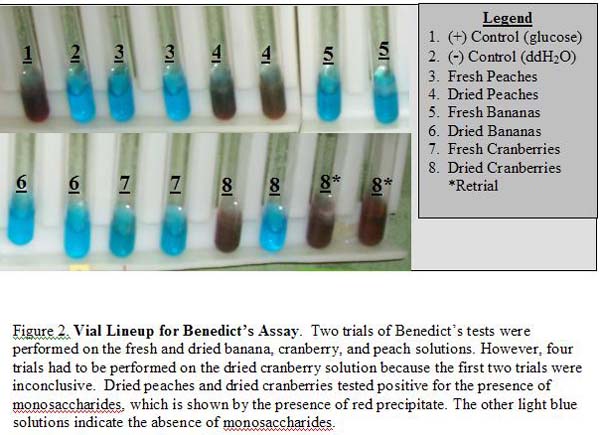

Carbohydrate and Protein Content Varies Moderately In Dried Bananas, Peaches, and Cranberries Compared to Fresh.
Abstract
By: Marisa Solano-Sanchez
This investigation studied the differences in certain nutritional aspects of fresh fruit versus their dried counterparts. Through a series of assays, Team 19 sought to determine if the dehydration process affects the presence of certain nutrients such as carbohydrates and proteins as well as physical qualities like pigment composition. A taste test was performed to gather quantitative results which were used to compare the sweetness of the fresh and dried fruits.
Benedict's assay tested negative for free ketones or aldehydes for all the fresh fruit and dried bananas but positive for dried cranberries and peaches. Barfoed's assay, which distinguishes monosaccharides from di- and polysaccharides, was also negative for all fresh fruits and dried bananas but was positive for monosaccharides in both the dried cranberries and peaches. Bial's assay showed no reaction in fresh cranberries but indicated the presence of pentose furanose in fresh bananas, peaches and dried bananas and indicted the presence of hexose furanose in dried cranberries and peaches. The i odine test was positive for fresh cranberries and dried bananas but was negative for all of the other dried and fresh fruits. The Bradford assay showed that bananas were the only fruit that had a noteworthy difference in the amount of protein. The dried version had an average of .127 concentrations higher than the fresh. The t-test analysis of the taste test showed that the dried fruit is significantly sweeter than the fresh fruit because the p value is greater/less than .05.
Discussion
By: Jillian Trombley
The purpose of this experiment is to determine if the chemical properties of carbohydrates, starches, sugars, proteins and absorbency are similar when comparing fresh fruit to fruit that has underwent the dehydration process. It is our hypothesis that the chemical properties of fresh cranberries, apricots, and bananas are not altered significantly when the fresh fruit is dehydrated. This prediction is supported by previous studies which dealt with the reconstitution of dried fruits and comparing grapes to raisins (Mastracola, 1995) (May, L., et. al. 2003). However upon completion of the carbohydrate and protein assays, it is evident that dehydration does have an effect on the presence of these nutrients in the fruit.
Benedicts assay was predicted to show positive results in the dried fruit for the presence of either free ketones or aldehydes depending on which is present in the fresh version of the fruit. If an aldehyde or ketone is present in the fresh fruit it is predicted that it will not be modified or lost in the dried fruit. This was predicted because the extraction of water from the fruits should have no effect on the sugar (Mullen, E. at el, 2004). Benedicts assay confirmed negative results for the bananas and banana chips. Both solutions remained blue colored therefore no presence of a free ketone or aldehyde group was detected in either case. This data supports the hypothesis because the sugars which are present in the fruit did not differ between the fresh and dried versions. On the other hand, Benedicts assay tested positive for a structure change in both cranberries and peaches. The fresh cranberry and peach solution tested negative for the presence of free ketones or aldehydes but the dried versions showed positive results for the presence of these functional groups. The dried cranberry solution initially showed conflicting results but upon further testing was positive for free ketones or aldehydes. These results are in direct conflict with our hypothesis. Benedict's assay provided conflicting data because the dried fruit tested positive for the presence of ketones or aldehydes while the fresh fruits indicated negative results. It was predicted that the fresh and dried fruit versions of a particular fruit would show no change. Overall this test did not support the hypothesis that no changes would occur in the fruit solutions.
Barfoed's test confirms the presence of monosaccharides in the fresh and dried fruits because the sugars in fresh fruits should be very similar to those in dried fruits from a qualitative standpoint (Mastracola, 1995). The fresh cranberry, banana, and peach solution tested negative for the presence of monosaccharides. All of the solutions remained a light blue in color during the test. The dried banana solution also tested negative for the presence of monosaccharides with all of the solutions remaining a light blue in color as well. This data conflicts with previous testing done on ripening bananas which showed that when a ripe fruit was used to make the 1% solution it tested positive for monosaccharides (Boerman, E., et. al. 2003). The cranberry and peach solution tested positive for the presence of monosaccharides, the solutions both turned dark blue within one minute of submission to a heat source. The chemical properties of the banana appear to remain unchanged during dehydration however the same cannot be said for cranberries and peaches. Barfoed's test illustrates that the molecular structure of cranberries and peaches forms a monosaccharide during dehydration.
Bial's assay is the only test that is predicted to show a slight difference between the dried and fresh fruits. This data was predicted and is supported by a previous study which showed that the fresh fruits tested positive for only the pentose furanose while the dried fruits showed the presence of hexose furanose (May, L., et. al. 2003). The fresh fruit banana and peach solutions tested positive for the presence of pentose furanose while the dried banana and peach solutions tested positive for the presence of hexose furanose. The fresh cranberry solution remained yellow indicating there was no pentose or hexose furanoses present. The dried cranberry solution tested positive for the presence of hexose furanose. A reason for these results may be due to the fact that the color of the dried cranberry solution resembled the brownish pigment resulting in a false positive for the presence of hexose furanose rings. A solution to this problem could be to dilute the solution until the color is too faint to resemble the brown pigment.
Bradford 's assay is thought to show how the dried fruits will have a similar concentration of protein when compared to the fresh fruits. This prediction is based on the idea that the two versions of fruit would not have any appreciable amount of protein. According to Consumer Information Center fruit is not a significant source of protein and should not be substituted for meat or nuts in a well balanced diet (USDA, 2005). Dried and fresh cranberry and peach solution supported the hypothesis. The assay resulted in similar amounts of proteins for the two fruits, however bananas which showed an increase of approximately .127 in protein from fresh to dry.
The Iodine test is predicted to be negative for all the fresh and dried fruits because they should all be devoid of starch. Starch breaks down during the cooking process therefore the dried fruit solutions should test negative because they underwent dehydration (Adams, J.B., 1991). The Iodine test showed no starch present in either peach solution. The fresh cranberry solution showed traces of blue/black color in both trials. The dried cranberry solution showed no presence of starches. The fresh banana solution tested negative for the presence of starches, however the dried banana solution tested positive for the presence of starches. Prior to the banana ripening, starch comprises between 80 and 90 percent of the carbohydrate content. Starch level decrease significantly as the banana ripens. The bananas could have been under ripe at the time of dehydration. This would explain the presence of starch. Also the bananas that make the fresh solution could have been over ripe, which would explain the lack of starch. (Adao, R., et. al., 2004) (Boerman, E., et. al., 2003). Both fresh and dried peach solution tested negative for starch.
A pH test was performed on the fresh and dried fruits solutions using a pH meter and probe. Both fresh and dried fruit solutions were predicted to have low levels of acidity. Mature fruits have a higher level of sugar and a lower level of acidity. The low acidity levels will result in pH readings above 6 on the pH scale (Genard, M., et. al., 2004). The predictions proved incorrect as both fresh and dried fruit solutions all had acidic pH readings. The acidity of the fruit could be caused by the natural acids that are present and used to deter bacteria (Dauthy, M.E., 1995). The average pH between trial 1 and trial 2 for dried banana was 4.28, fresh banana was 4.56, dried peach was 3.34, fresh peach was 5.12, dried cranberry was 2.85, and fresh cranberry was 3.095. All of the fresh fruits were more acidic than their dried counterparts indicating that natural acids could be lost during dehydration.
The absorbencies of the fresh and dried fruit were collected in the range of 400 nm to 700 nm. For dried cranberries, the absorption spectrum showed valleys at 610nm while the fresh cranberries had valleys at 550 nm and 580 nm. The dried peaches had a valley at 610nm and the fresh had valleys at 550 nm and 580 nm. The dried bananas had a valley at 610 nm but the fresh had valleys at 550 nm and 580 nm . The valleys illustrate where the light is absorbed.
The taste test is predicted to show that students will sense a higher sensation of sweetness in dried fruits because, as stated earlier, the dried fruits will have a higher concentration of sugars. The dehydration process is known to significantly increase the sugar content of fruits (Kaushal, B.B.L., et. al., 2004). The null hypothesis that there is no difference in taste of sweetness between fresh and fried fruits was rejected. It was rejected because the t-test comparing the sweetness of each of the fresh and dried fruits had p values less than .05. The p value comparing cranberries to dried cranberries was 1.09E-08. Comparing fresh and dried peaches, it was 3.03E-10 and for fresh and dried bananas the p value was 4.35E-08. This indicates that there is a significant difference of sweetness of each fresh fruit and its dried counterpart. The mean sweetness of dried is higher than its fresh fruit counterpart to a degree where they can be considered separate populations.
A mistake occurred during Benedict's testing. The first trial of dried cranberries turned red, a positive for reducing sugars however trial two was tested negative. A third and fourth trial were performed and the dried cranberries tested positive for reducing sugars both times. The error that occurred in trial two could have been caused by the wrong solution being placed in the beaker. There were many beakers with clear solution and a mix up could have occurred due to misreading the labels. A mistake also could have occurred when pipetting the fresh cranberry solution for the Iodine test. A mistake in solution could explain traces of blue/black color. A mistake occurred during the second half of the taste test which was administered in North Wonders. Signatures were not obtained but a verbal agreement was reached and the actual surveys were collected. In a future study, signatures must be obtained in order to avoid any legal problems that may occur as a result of the test.
